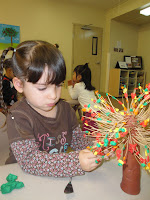 What would you have done with this collection of leaves?
What would you have done with this collection of leaves? Children always find a way to guide us. These young toddlers took the opportunity to sort the leaves.
Children always find a way to guide us. These young toddlers took the opportunity to sort the leaves.This excerpt tells us why this is a valuable exercise in constructing knowledge.
Understanding Same and Different (Classification)
Authors: Jandy Jeppson with Judith A. Myers-Walls, PhD, CFLE
Children who create a leaf collection or a bug collection are learning other things, too. They are learning how to classify leaves and insects by putting them into groups. When you plan meals for your family or your childcare program, you are using classification, too. Deciding whether a food is bread, vegetable, or dairy product is classification.
Putting together things that are the same is called classification. When children classify, they are using information about what is the same and what is different. This learning happens over time. At first, children classify items based on how they look, sound, and feel.
Children first group things by appearance. Young children may believe that a ball and a head of lettuce go together, because they are both round. A child may learn the word “doggie” after petting one. The next day he may see a cat and say “doggie,” because they are both animals with four legs. An apple and a stop sign go together, because they are both red.
Young children also learn that things can sound the same or different. Babies learn very early to recognize people’s voices. As they get older, they learn that some musical notes are the same, and some are different.
Later, children learn that some things belong together because of what they do or how they are used—their purpose. An umbrella and a newspaper could be classified together because they can protect you from the rain. A birthday card and a newspaper may be the same, because you can read both of them. But they don’t look alike.
http://www.extension.purdue.edu/providerparent/Child%20Growth-Development/UnderstandingSameDiff.htm






















